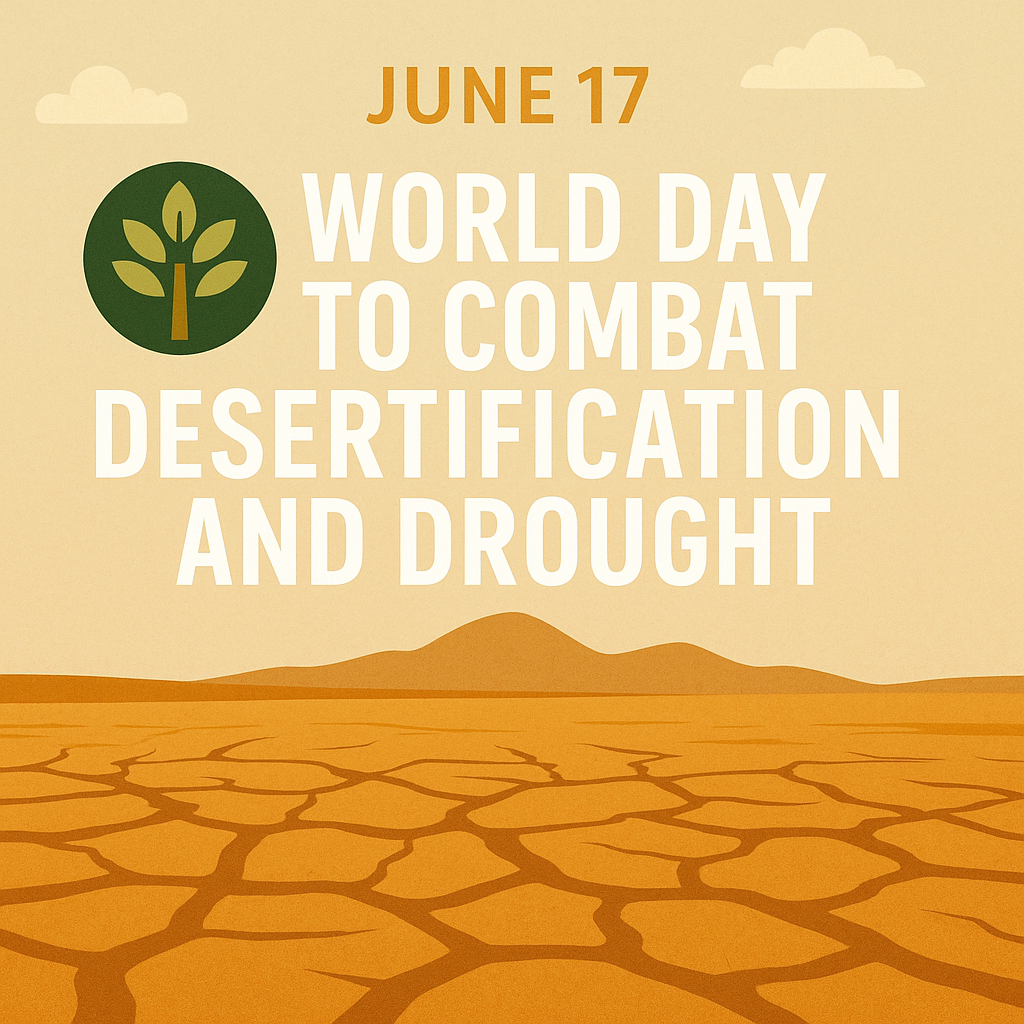
🧭June 19, 2025 Post 2: Restoring the Sands of Life: India’s Commitment on World Day to Combat Desertification | High Quality Mains Essay: Restoring the Sands of Life: India’s Commitment on World Day to Combat Desertification | For IAS-2026 :Prelims MCQs
Restoring the Sands of Life: India’s Commitment on World Day to Combat Desertification

INTERNATIONAL
🗓️ Date Observed: June 17, 2025
📚 Thematic Focus: GS3 – Environment, Climate Resilience, Sustainable Land Use
🌀 Intro Whisper
“Even barren land remembers the forest it once held.”
On June 17, the world turned its eyes toward Earth’s drying lands and eroding soils. India joined the global community to reaffirm its pledge to heal the planet’s wounds on the World Day to Combat Desertification and Drought, echoing the 2025 theme: “Restore the Land. Unlock the Opportunities.”
🌍 Key Highlights
- UN Day Observance: Observed every year on June 17, this day marks global solidarity to reverse land degradation and restore ecological balance.
- Theme 2025: Restore the Land. Unlock the Opportunities – emphasizing how land restoration creates jobs, enhances food security, and combats climate change.
- India’s Concern: As per ISRO’s Desertification Atlas (2021), 29.7% of India’s land is degraded or desertified, with high vulnerability in Rajasthan, Gujarat, Maharashtra, and Telangana.
- Drivers of Desertification:
- Deforestation, overgrazing, unsustainable agriculture
- Erratic rainfall, over-extraction of groundwater
- Infrastructure expansion and soil salinization
- India’s Strategy:
- NAPCC missions like Green India & Sustainable Agriculture.
- CAMPA and Compensatory Afforestation efforts.
- Desert Development Programme (DDP).
- Mangrove Protection Action Plans under National Coastal Mission.
- India is also a party to UNCCD since 1996, and hosted COP-14 in 2019.
🧭 GS Paper Mapping
| 🔹Dimension | 🔸Mapped Content |
|---|---|
| GS3 – Environment | Desertification, Climate Adaptation, Land Use Policy |
| GS3 – Agriculture | Sustainable Farming, Watershed Management |
| GS2 – Governance | CAMPA, NAPCC Missions, Coastal Management Schemes |
| GS2 – International Relations | India’s role in UNCCD, Bonn Challenge, SDG 15.3 |
🌿 A Whispering Thought
“The desert isn’t dead — it simply waits for rain. So too must humanity wait with resolve, to restore what it has taken.”
— IAS Monk
High Quality Mains Essay For Practice :
Word Limit 1000-1200
Restoring the Sands of Life: India’s Commitment on World Day to Combat Desertification
Each year, the world pauses on June 17 to mark the World Day to Combat Desertification and Drought, a poignant reminder that the health of our lands is intrinsically tied to the well-being of our people and the stability of our climate. In 2025, the global theme—“Restore the Land. Unlock the Opportunities”—underscores the urgent need for collective action in rehabilitating degraded ecosystems and reviving the productivity of soils that sustain life.
India, with its vast and ecologically diverse terrain, faces significant challenges related to land degradation. Yet, it also holds the potential to become a global leader in ecological restoration. On this international day, India reaffirmed its dedication to combat desertification through a renewed national focus on sustainable land use, climate-resilient agriculture, and ecological regeneration.
Understanding Desertification: More Than Just Dust and Dunes
Desertification, as defined by the United Nations Convention to Combat Desertification (UNCCD), refers to land degradation in arid, semi-arid and dry sub-humid areas, driven by climatic shifts and unsustainable human activity. This process doesn’t merely threaten the ecological balance; it tears through the fabric of rural livelihoods, food systems, and water security.
The ISRO Desertification Atlas (2021) revealed a stark reality: 29.7% of India’s total geographical area is undergoing land degradation or desertification. This includes states such as Rajasthan, Maharashtra, Gujarat, and parts of the Deccan plateau where years of drought, deforestation, and reckless exploitation of natural resources have turned once-fertile tracts into barren stretches.
But this phenomenon is not confined to India alone. Globally, $878 billion is lost annually to land degradation, affecting over 3.2 billion people. From the Sahel in Africa to Central Asia, from the Middle East to the Indo-Gangetic plains, the creeping loss of soil fertility and vegetation cover is undermining both peace and prosperity.
The Causes: When Nature Collides with Negligence
The drivers of desertification are multifaceted and interconnected. Erratic rainfall, drought, and rising temperatures—all hallmarks of climate change—exacerbate natural vulnerabilities. However, the more insidious culprits are rooted in unsustainable land-use practices:
- Deforestation and Overgrazing strip soil of protective cover.
- Excessive groundwater withdrawal and poor irrigation practices increase salinity and compact soil.
- Industrial expansion, mining, and infrastructure projects often proceed without ecological assessments, leading to irreversible damage.
- Urbanization, particularly in peri-urban landscapes, swallows agricultural land and wetlands, reducing the landscape’s ability to recharge and regenerate.
These activities amplify natural degradation, creating feedback loops that intensify poverty, displacement, and ecological fragility.
India’s Response: A Policy Landscape for Greener Futures
Recognizing the threat, India has developed a multilayered institutional framework to combat desertification and restore its landscapes.
- National Action Plan on Climate Change (NAPCC): Two key missions—Green India Mission and National Mission on Sustainable Agriculture—aim to enhance ecosystem services and climate resilience through afforestation and agro-ecological practices.
- CAMPA and Afforestation Efforts: Under the Compensatory Afforestation Fund Management and Planning Authority (CAMPA), degraded forests are being replanted and community forests developed to offset environmental losses.
- Desert Development Programme (DDP): Operational in 235 districts, this program integrates watershed management with sustainable land-use techniques in drought-prone areas.
- Forest Fire Prevention and Management Scheme (FFPM): Recognizing that forest fires significantly contribute to land degradation, this scheme promotes early warning systems and community-based firefighting.
- Mangrove and Coastal Management: Through the National Coastal Mission, India is investing in the protection and expansion of mangroves, coral reefs, and coastal wetlands, acting as natural buffers against erosion and climate events.
- Data-Driven Restoration: With support from ISRO, India now uses remote sensing and GIS mapping to monitor desertification trends, enabling more targeted and timely interventions.
Global Engagements: A Champion of the Global South
India is not acting in isolation. It has emerged as a vocal and proactive participant in international platforms:
- UN Convention to Combat Desertification (UNCCD): India has been a party since 1996 and hosted the 14th Conference of Parties (COP-14) in New Delhi in 2019, where it pledged to restore 26 million hectares of degraded land by 2030.
- Bonn Challenge: India is among the signatories aiming to restore 350 million hectares globally. India’s target: 13 million hectares by 2020 (partially achieved) and 8 million more by 2030.
- Sustainable Development Goals (SDG 15.3): India is committed to achieving Land Degradation Neutrality (LDN) through partnerships, financial mechanisms, and knowledge sharing.
Impact and Challenges on the Ground
Despite significant progress, implementation remains uneven across states. Many afforestation projects under CAMPA have faced criticism for:
- Monoculture plantations that fail to support biodiversity or local livelihoods.
- Poor community involvement, leading to low survival rates of plantations.
- Inadequate coordination between central, state, and panchayat bodies.
Moreover, population pressure, competing land demands, and political inertia continue to undercut long-term ecological planning. Without community ownership and socio-economic incentives, land restoration risks becoming a top-down exercise with little transformative effect.
The Way Forward: From Wastelands to Wonderlands
Restoring degraded land is not just an ecological imperative—it’s an economic and ethical necessity. The path ahead must embrace both traditional wisdom and technological innovation.
- Integrated Land Use Planning: Land-use policies must align with agro-climatic suitability, watershed science, and ecological corridors. Every hectare of land should serve multiple functions—ecological, economic, and cultural.
- Sustainable Agriculture: Scaling up organic farming, agroforestry, and natural farming systems like Zero-Budget Natural Farming (ZBNF) will reduce the input burden and rejuvenate soil health.
- Community-Driven Watershed Management: Empowering Panchayats, Farmer Producer Organizations, and Self Help Groups to design and manage restoration projects will enhance local accountability and outcomes.
- Scientific Monitoring and AI Tools: Deploying drones, satellite analytics, and AI-based predictive models will help anticipate degradation patterns and preempt disaster risks.
- Blended Financing Models: Encourage green bonds, public-private partnerships, and carbon credits to finance landscape restoration while ensuring benefit-sharing with local communities.
- Education and Behavioural Change: A long-term cultural shift is needed—from extractive land use to stewardship. Campaigns like “Catch the Rain” and Mission LiFE (Lifestyle for Environment) should be scaled up to change public attitudes.
Conclusion: Land is Life, and Life Must Be Restored
As the sands shift under our feet—both literally and metaphorically—the message of the World Day to Combat Desertification is clear: land is not an infinite resource. Its degradation threatens food, water, biodiversity, and climate stability. But its restoration holds the promise of reversing poverty, hunger, and displacement.
India, with its diversity of ecosystems, its deep-rooted traditions of conservation, and its youthful population, is uniquely positioned to lead this global movement. The challenge is formidable. But so is the opportunity.
As we commemorate this day, let us remember—to restore the land is to restore the future.
Target IAS-26: Daily MCQs :
📌 Prelims Practice MCQs
Topic: World Day to Combat Desertification
MCQ 1 – Type 1: How many of the above statements are correct?
Consider the following statements regarding land degradation and desertification:
1. Nearly 30% of India’s total geographical area is affected by desertification or land degradation.
2. Africa and South America are the worst affected regions globally.
3. The annual global economic cost of land degradation is estimated to be around $878 billion.
4. India hosted the UNCCD COP-14 summit in 2019.
How many of the above statements are correct?
A) Only one
B) Only two
C) Only three
D) All four
🌀 Didn’t get it? Click here (▸) for the Correct Answer & Explanation
✅ Correct Answer: C) Only three
🧠 Explanation:
•1) ✅ True – ISRO’s Desertification Atlas (2021) states that 29.7% of India’s TGA is under desertification or degradation.
•2) ❌ False – Africa and Asia, not South America, are the worst affected.
•3) ✅ True – As per UNCCD estimates, land degradation costs the world ~$878 billion annually.
•4) ✅ True – India hosted the UNCCD COP-14 in 2019 in New Delhi.
MCQ 2 – Type 2: Two Statements Based
Consider the following statements:
1. The 2025 theme for World Day to Combat Desertification is “Land Belongs to the Future – Let’s Restore It.”
2. According to UNCCD, over $800 billion is lost globally each year due to land degradation.
Which of the above statements is/are correct?
A) Only 1 is correct
B) Only 2 is correct
C) Both are correct
D) Neither is correct
🌀 Didn’t get it? Click here (▸) for the Correct Answer & Explanation
✅ Correct Answer: B) Only 2 is correct
🧠 Explanation:
1) ❌ False – The 2025 theme is: “Restore the Land. Unlock the Opportunities.”
2) ✅ True – Land degradation costs the global economy $878 billion annually.
MCQ 3 – Type 3: Which of the statements is/are correct?
Which of the following statements are correct regarding India’s desertification combat strategies?
1. The Desert Development Programme (DDP) focuses on integrated watershed management in arid zones.
2. India uses remote sensing and GIS tools for real-time tracking of land degradation.
3. CAMPA is responsible for compensatory afforestation and forest fire prevention.
Select the correct code:
A) 1 and 2 only
B) 2 and 3 only
C) 1 and 3 only
D) 1, 2 and 3
🌀 Didn’t get it? Click here (▸) for the Correct Answer & Explanation
✅ Correct Answer: A) 1 and 2 only
🧠 Explanation:
1) ✅ True – DDP is aimed at integrated watershed-based land restoration.
2) ✅ True – India relies on ISRO-based remote sensing for monitoring.
3) ❌ False – CAMPA manages afforestation but forest fire prevention is handled under FFPM Scheme, not CAMPA.
MCQ 4 – Type 4: Direct Fact
Which of the following is the nodal international agency coordinating global efforts to combat desertification?
A) UNEP
B) UNCCD
C) UNFCCC
D) UNDP
🌀 Didn’t get it? Click here (▸) for the Correct Answer & Explanation.
✅ Correct Answer: B) UNCCD
🧠 Explanation:
• The United Nations Convention to Combat Desertification (UNCCD) is the principal international agreement focused specifically on land degradation and desertification.


















